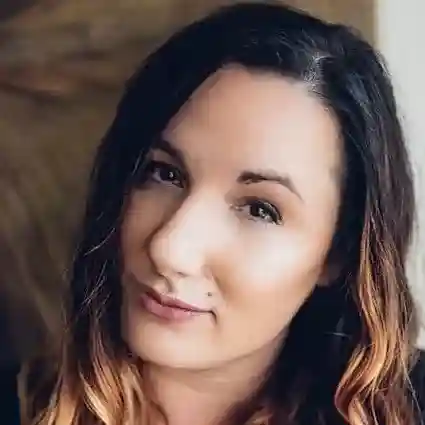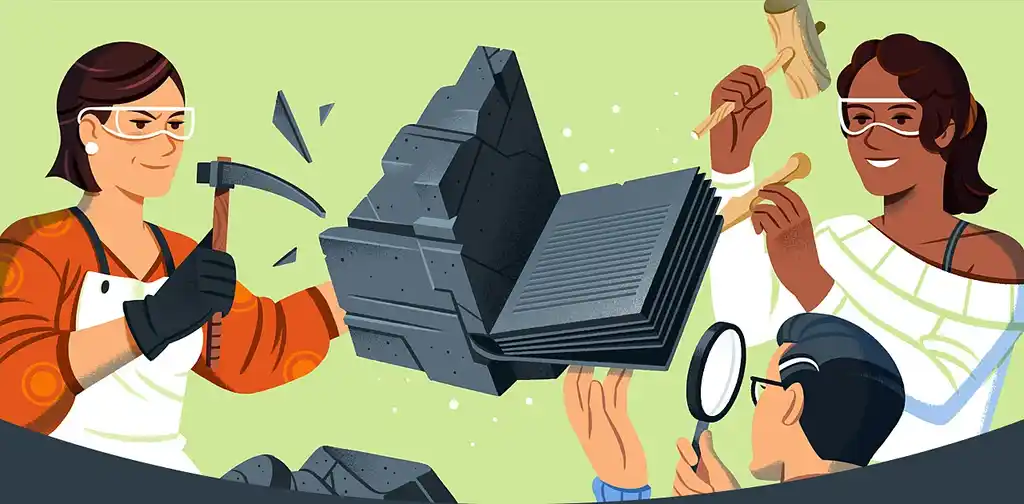This transcript has been edited for length and clarity.
I like to start with: what makes Kickstarter unique? At Kickstarter, our mission is to bring creative projects to life. That is, everything that we do comes back to that goal. We believe so strongly in that mission, and in 2015, Kickstarter reincorporated as a public benefit corporation. We’re required to consider our impact on the world with all of our choices. We can't be coerced by shareholders, stockholders, investors to chase profits if that comes at the expense of our mission. So, we're essentially a mission-driven, for-profit organization.
Kickstarter is also a very progressively run organization. We have strong values for diversity. We do diversity surveys. We have pledged to keep the highest and the lowest salaries stay within a certain range of each other. We donate 5 percent of our after-tax earnings every year to arts and culture organizations and organizations fighting inequality. I feel pretty, pretty honored to be a part of it.
How Kickstarter Fundraising Works
On the more technical side, Kickstarter's funding model is all or nothing. That means that if you set out to raise $10,000 and you only raise $4,000, you don't get any of the dollars.
People think that seems scary, but it was actually designed with creative people in mind. The idea is that throughout your campaign, you're going to make a lot of promises about the thing you're going to create, the rewards associated with it, your timeline, your shipping, your budget.
But if you get to the end and you've only got part of the money that you need, you're actually in a very bad spot. You're going to either have to sell fun to come up with the rest of it, maybe produce an inferior product, maybe not fulfill it at all, all of which are really bad outcomes.
So, our goal is to make sure that nobody's trying to bring their work to life with an incomplete budget.
Another thing that I think is really important about Kickstarter is that we're in the business of giving you your audience. We've been doing this long before everybody realized that all the work they've been doing, building up audiences on various social platforms, can disappear in the blink of an eye, when an algorithm is tweaked or changes are made internally.
So, when you run a Kickstarter campaign, we give you a ton of demographic information during the campaign to help you figure out whether your outreach and promotion is working well. We share where people are from, what kind of device they're using to book, where they've seen ads for your campaign, things like that.
And then after a project is over, we give you immediately everybody's first name, last name, and email address. So, these are folks that we expect you are going to be absorbing into the greater community around your work, and that's an audience that we want you to be able to keep having access to long after the campaign is over.
Finally, Kickstarter's fee is 5 percent. This is an industry setting fee that we did when we launched and have never raised. We take 5 percent of completed projects. So, if you run a campaign that doesn't reach its funding goal, you don't owe anybody any money. On top of this, our payment processor, Stripe, takes a 3 to 4 percent variable that's based on where all the bank accounts are around the world.
So, for a Kickstarter campaign, if you budget 10 percent for fees, you'll be more than covered and you'll be paying a lot less than many of the other places where you might go to sell your writing.
About #KickstarterReads
Some stats about #KickstarterReads, which encompasses publishing, comics, and journalism, anything in the world of words:
- Since Kickstarter launched in 2009, 98,000 projects have launched.
- $610 million have been pledged by more than 4 million individual backers.
- 2023 was our fourth-best year ever in a row in publishing and comics, andhat's also true for games. The current success rate for these categories is 63 percent, which is pretty good. It's higher than the site average.
But another metric — my favorite metric that we love to look at — is projects with at least 25 backers.
We think this is an important indicator because 25 backers is a little bigger than your mom, your best friend, the folks who are obligated to donate to any kind of project you put in front of them. So, 25 backers means you're reaching outside that inner circle. You're taking the project seriously, you're marketing it well.
The success rate in my categories for projects with at least 25 backers is 85 percent — that’s tremendously high. I think that's double the site average, actually.
The Benefits of Literary Crowdfunding
Let's talk about some of the benefits of literary crowdfunding, or, Why would you do something like this?
Kickstarter is a platform that's designed to help you share the story of your creative work. Of course, that means you're going to detail the plot of the book that you're writing, but it also lets you talk about who you are, what brought you to this work, what inspires you, your collaborators, your budgets, your timeline… the whole story of what it is you're doing, how you're going to do it, when you're going to do it, and why.
Kickstarter is a platform that helps you connect directly with your audience. This is something that is really not available in most other parts of the publishing landscape.
You can talk to your readers and your fans before the campaign to get them excited about it. You can work with them during the campaign. You can have surveys that say: Should we go with the blue cover or the red cover? If we get $1,000 over our goal, what kind of extra rewards would you like to see?
And you can talk to them, as I said, afterwards. This is a way to keep giving you that direct line between readers and writers, between authors and their fans.
A Kickstarter campaign can help you build awareness of your work. Through the course of the campaign, you're going to be shouting from the rooftops to both the audience that you have and the audience that you want.
So, you can turn a release of a new book or a reissue of a previous book or something like that. You can really make it into a moment. Build up your brand awareness and market it in all the ways that you can.
Kickstarter allows you to sell through pre-orders or sell through your backlist. For legal reasons, you can't actually call it pre-orders, but a lot of authors run their campaigns in that way. The idea being that, the book is written, it's edited, proofread, typeset, ready to send to the printer, so you're gathering funds to pay those production costs.
And then through the rewards, if you have other books, you can sell them as individuals, bundles, and that helps you get rid of that overstock that you might have sitting in your garage.
Kickstarter is a great way to test out an ambitious idea because, as I said, if you run a campaign and it doesn't fund, all you've lost is your time. So, if you think there's an audience for moving into a new genre, doing a big compilation, an anthology with other authors, or something else that's bigger, weirder, more ambitious, then you might be able to stomach doing it without having the benefit of assessing your audience and getting your money upfront. Kickstarter is a terrific place to try to make that happen.
Finally, Kickstarter helps you delight your readers with something unique. Your project will be to fund one main item, but all of the rewards can take you in so many different directions.
As I said, I've got a slide at the end that talks about some really unique and cool reward ideas, but it doesn't have to be, you know, just swag. There's all kinds of things that you can do to bring your audience and your readers into the creative world of your work and make them really excited to support you on this journey.
Diving into Case Studies
Now, I'll go into some case studies. I imagine a large number of you may have first heard about Kickstarter when Brandon Sanderson ran his campaign last year.
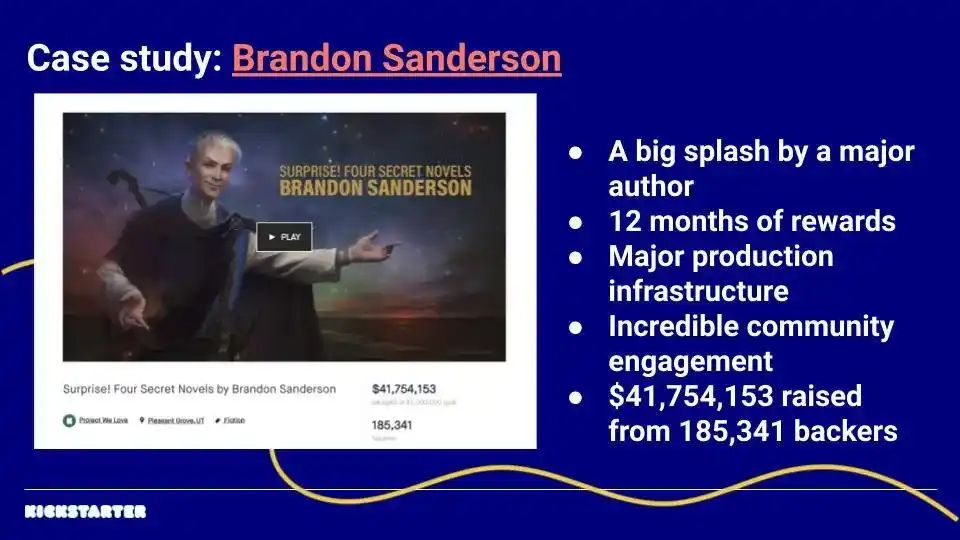
This is the highest-funded Kickstarter campaign ever, not just publishing campaign. It is actually more than double the amount of the previous highest-funded project, which was for watches. There has never before been a publishing project, I think, even in the Top 20. So, to careen up into that top spot was very exciting.
If you are not familiar with the campaign, this was called “A Year of Sanderson.” Over the course of the early pandemic days, Brandon wrote four new never-before-seen novels, and so he created this whole campaign for all of 2023. His backers would get a package from him every single month. Four of those would be these brand new books and the others were themed swag boxes that were themed around the various worlds that he writes. Really high-end, beautiful items.
This was a major, major project with massive production infrastructure. Brandon was not putting all these things in boxes for his almost 200,000 backers in his own house. He's got a staff of close to 80 people at a warehouse out in Salt Lake City.
He also came to the project with incredible community engagement. He's a very well-known author, and he's known for his close interaction with his fans. He's got half a million YouTube subscribers and he does videos all the time.
So, while this is an incredible, aspirational, beautiful campaign that we were very pleased to support and have on our platform, I don't want to set the expectation that this is the kind of thing that every author might be able to do.
But it is one of our shining stars, so it seems like a good place to start. Brandon having done that kicked off a huge bump in special editions. We're seeing these in all sorts of genres, but in, you know, books overall, these are people who are really elevating these books as art objects.
We're seeing all kinds of nerdy, print production stuff. We've got spot gloss and foil and sprayed edges and ribbon bookmarks and vellum art inserts. It's really, really exciting, and also the kind of project that is perfect to fund on Kickstarter because getting the money upfront, understanding what size print run you want to make, is really handy when you're spending a lot of money on flashy production.
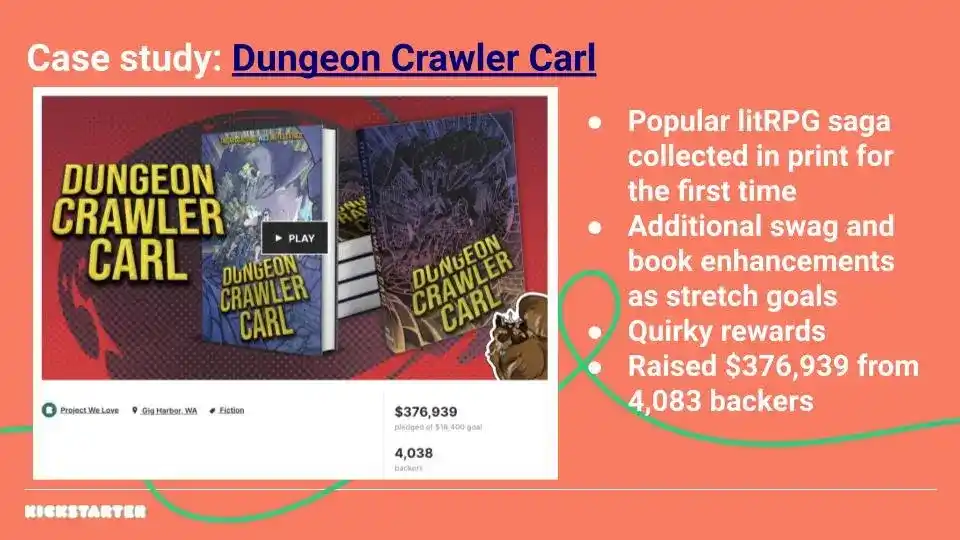
Another nice campaign recently: Matt Dinniman ran a project for Dungeon Crawler Carl. He's a very popular LitRPG writer. There's a huge games community on Kickstarter, so LitRPG is a really nice crossover from publishing that captures a lot of the same audience. His books have been released in various bits and bobs, in ebooks and audiobooks and small collections. So this was the first time the whole thing was collected in print.
Matt did additional swag and book enhancements via his stretch goal, so he said, “If we raise this much, you're going to get a hardcover book. If we raise this much more, we're adding a signature. This much after that, a ribbon bookmark.”
He also had very cool quirky rewards. Among my favorites, for $666, he promised to kill you off in his next book, and for $777, he vowed to let you live. So, this was a really fun campaign. He took it with a lot of joy and it went very, very well.
It's a good example of the genre fiction we see on the site, of which there is a lot. Sci-fi, fantasy, mysteries, romance, queer books. We also see literary fiction, really any kind of project you can think of, you can fund on Kickstarter.
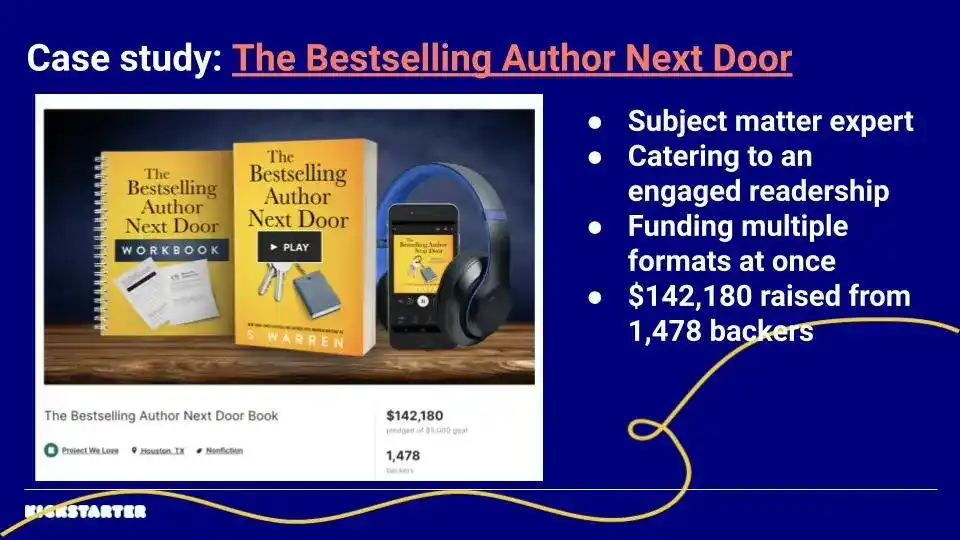
There's also plenty of nonfiction. For example, Skye Warren wrote The Bestselling Author Next Door. She's a subject matter expert with a deep audience in “how to for writers.” She is also herself a bestselling novelist, catering to a really engaged readership, the kinds of people that are likely to be on Kickstarter already looking at other books.
This is a cool campaign in that she funded multiple formats at once. Paperback, hardcover, ebook, audiobook, also these workbooks. There was a real “choose your own adventure” vibe to the campaign. You could pick whichever method you wanted to receive your book in, ultimately. She did beautifully, $142,000 raised from just shy of 1,500 backers.
There's a lot of other kinds of nonfiction that we see all the time. There's a lot of cookbooks, “business guru” projects, memoirs, self-help in all of its formats, really anybody who's writing in nonfiction and has a good line to their audience can find really good success here.
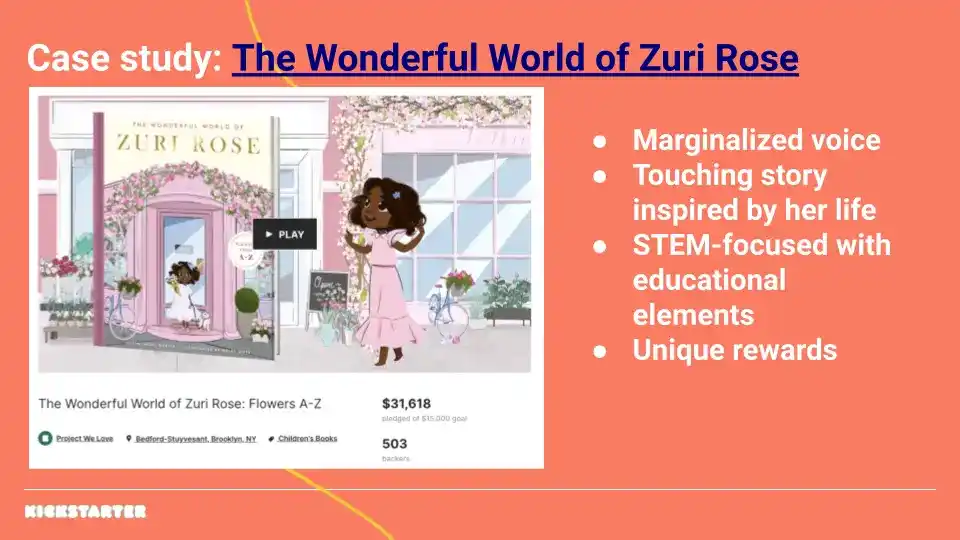
Another area I love to see: we've got a very strong community in children's books. For example, The Wonderful World of Zuri Rose. This was by a woman from a marginalized community, and she wrote this whole story inspired by her life. She was a floral arranger for high-end weddings, so in addition to being a lovely story, she's got all these STEM-focused elements about botany and flowers throughout the book.
She also had unique rewards. You could get custom flower arrangements. I think she had PDFs of: Tell her your favorite flower and she would tell you some fun facts about them. Really bringing in that vibe to the project.
And we see children's books of all sorts, but really particularly the Own Voices stuff. We see a lot from the language, culture, and food of, you know, non-American societies. A lot of projects for queer kids, for disabled kids. The kinds of books that have been largely ignored by the traditional publishing industry tend to be the ones that can find a really good home at Kickstarter in children's books and beyond.
Sharing Reward Ideas
Swag is lovely. People really like custom merch, but doing a Kickstarter doesn't mean that you need to turn yourself into a merch production facility.
You can do all sorts of things that are not going to cost you money to package and ship: custom playlists, editorial reviews, writing backers into the story like Matt Dinniman did. Whatever your skill set is!
You can do consultations, whether that's storytelling, social media, business stuff, humor writing. We see lots of people commissioning original art, often from their friends and people in their community that want to donate to help them reach their goal.
People host events like book clubs, whether of their book or other books like it. Lunch parties, you can do virtual or IRL. Cooking classes, for sure. You can get homemade goods, or handmade goods, often either themed to your project and/or made by small businesses or folks in your community. We see this a lot with the romance novels, like for homemade bath bombs. Also, candles that have a specific scent that factors into the story itself, that sort of thing.
We're seeing a lot of IP crossover with stuff like tarot cards, tabletop board games, illustrated maps, things like that. And of course, with a lot of the children's books, you're seeing handmade toys. So, those are just a few ideas.
I think that rewards are so central to the Kickstarter proposition, and that's the place where you can really come up with the most interesting and creative things that will be fun for you to make and also really, really exciting for your readers to have.
Wrapping It Up
Finally, here are some helpful links. I would say that my number one advice, if you are considering running a Kickstarter someday, go to this link right now, find five campaigns that you like and back them, even for a buck or two. Find and follow those creators out in the world.
Start getting a sense of how people are talking about their campaigns, how people are running their projects, the cadence of their updates, the types of rewards they're offering. Figure out what everybody's doing, unabashedly steal all of the best ideas and incorporate them into your own project.
I have a curated Publishing Creator Tips page that's got a number of videos just like this one of my face in various screens. I've also got a lot of articles that I've commissioned around how to write a press release for your campaign, how to build your audience, how to promote your project.
I just had one from a youth comics librarian out in California. She wrote an article about how to get your Kickstarter-funded book into a library and why you would want to. So, there's lots of tips and tricks on that page that will be really helpful.
Of course, the Kickstarter Creator Handbook, that'll take you through every single step of your crowdfunding journey.
Finally, we have an Experts page. It is by no means exhaustive, and you should certainly do your own research, but it's got a lot of organizations and companies that do print production, vinyl pressing, make playing cards, all of the different elements of things that you might include in your campaign. It also has some tips to find folks who might be able to help create those things for you.

